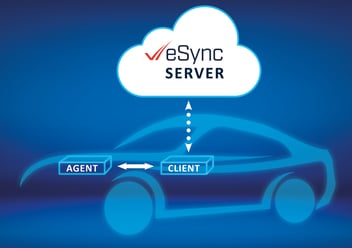Did you know that reliance on traditional diagnostic methods—like repair-shop diagnostic systems with plug in to the vehicle’s OBD port—is no longer sufficient in the age of software-defined vehicles (SDVs)?
Today’s cars operate as rolling data centers with dozens of ECUs, sensors, and high-performance computers. Managing them requires more than legacy troubleshooting—it demands a vehicle diagnostic framework that is secure, scalable, and remote-ready.
That’s why the Association for Standardization of Automation and Measuring Systems (ASAM) developed the Service-Oriented Vehicle Diagnostics (SOVD) standard. And when paired with Excelfore eSync OTA, this standard is reshaping how automakers, technicians, and fleet managers manage connected vehicles across their lifecycle.
ASAM SOVD: A Modern Framework for Vehicle Diagnostics
Unlike traditional diagnostic protocols, ASAM SOVD takes a service-oriented approach. Built on RESTful APIs, it abstracts away the complexities of legacy ECU communication, allowing faster and more flexible vehicle diagnostic interactions.
Key benefits include:
- Standardized access to diagnostic trouble codes, logs, and sensor data
- Simplified retrieval of software versions across devices
- Independence from specific vehicle architectures
- Scalable integration for SDVs and connected fleets
This enables technicians and OEMs to run diagnostics in real-time—whether locally, remotely, or via edge platforms—ensuring quicker resolutions and improved uptime.
eSync: The Secure Backbone for OTA Updates
Diagnostics alone aren’t enough. To be effective, modern vehicle diagnostic processes must be directly connected to update mechanisms. That’s where the eSync OTA platform comes in.
eSync provides a modular system of cloud servers, in-vehicle clients, and distributed agents.
Together, they ensure every update is:
- Encrypted
- Authenticated
- Authorized
- Traceable with audit logs
When paired with ASAM SOVD, eSync isn’t just an update engine—it becomes a lifecycle management system that integrates diagnostics, monitoring, remote repairs and updates in one seamless pipeline.
Integrated Use Cases: Smarter Vehicle Diagnostics in Action
What does this integration mean for real-world fleets? Let’s break it down.
- Remote troubleshooting – Technicians can assess error codes and software state remotely, cutting down dealership visits.
- Dynamic updates – Tailored to specific ECUs or hardware configurations, ensuring compatibility.
- Parallel ECU updates – Multiple ECUs updated simultaneously to reduce downtime.
- Predictive maintenance – Real-time diagnostic data allows early detection of potential issues, preventing breakdowns.
These use cases enable both service efficiency and customer satisfaction, transforming diagnostics from a reactive to a proactive approach.
Why This Matters for OEMs and Fleets
The ASAM SOVD + eSync OTA combination helps automakers and fleet operators:
- Streamline backend infrastructure with standardized frameworks
- Lower service costs by reducing physical visits and downtime
- Deliver updates faster and more securely to end-users
Think about the difference: instead of waiting for a check-engine light, remote vehicle diagnostic tools can catch issues early and push corrective updates OTA—often before the driver even notices.
Excelfore’s Role in Driving Standards
As a proud member of both ASAM and the eSync Alliance, Excelfore has been at the center of these advancements. Our contributions to the ASAM SOVD + eSync white paper reflect our deep expertise in:
- Automotive Ethernet and in-vehicle network protocols
- Vehicle diagnostics frameworks
- OTA software delivery for connected vehicles
We continue to shape global standards that enable smarter, safer, and more efficient automotive ecosystems.
FAQs
Q1. What is ASAM SOVD in simple terms?
A standardized, API-based framework that makes modern remote vehicle diagnostic processes scalable and architecture-agnostic.
Q2. How does eSync enhance vehicle diagnostics?
It combines diagnostics with OTA updates in a secure lifecycle management platform—making it easier to resolve issues remotely.
Q3. Can SOVD replace traditional OBD tools?
Not immediately. OBD tools still have value, but SOVD represents the next-gen framework for SDVs, offering far more flexibility and scalability.
Q4. What’s the benefit for fleet managers?
Faster fault isolation, reduced downtime, predictive maintenance, and improved service efficiency across large fleets.
Final Thoughts
As vehicles continue to evolve into software-driven machines, their diagnostic processes must also adapt.
The integration of ASAM SOVD and eSync OTA provides a secure, scalable, and standardized approach to lifecycle management—helping OEMs and fleets deliver safer, smarter, and more reliable mobility.
Excelfore is proud to play a leading role in this journey—shaping the standards and solutions that will define the future of connected vehicles.




Leave a Comment